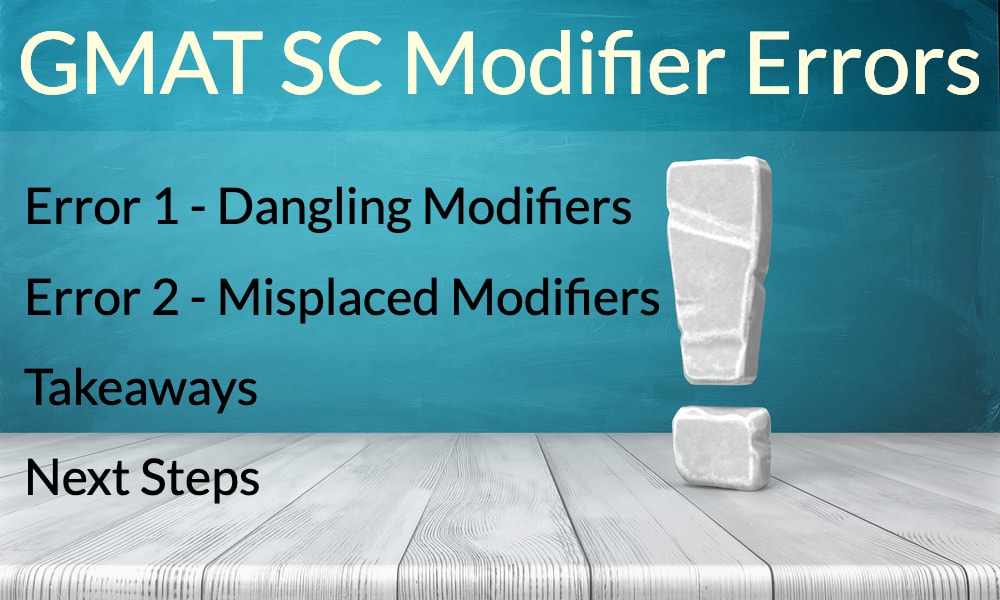GMAT Modifier Errors
Modifiers are words or group of words that describe other entities in a sentence. Modifiers can act as adjectives, describing nouns or pronouns. Or they can act as adverbs, describing verbs, clauses, and other adjectives.
Regardless of whether a modifier is a word or a phrase or what it modifies, when it is used in a sentence, the meaning of the sentence must be absolutely clear.
Here are some of the errorspertaining to Modifiers that GMAT introduces:

Error Type 1 – GMAT SC Modifiers – Dangling Modifiers
In a sentence, if the entity that is being described by the modifier is not explicitly stated, then we have what is called as a dangling modifier. The terminology is pretty straight forward – dangling means something that dangles i.e. something that cannot logically point to anything in the sentence. Let’s see some examples.
Example 1 – Dangling modifiers – GMAT SC
Driving on the I-40 freeway, Las Vegas strip came into view.
Per the sentence above, it appears that “Las Vegas strip” was driving. But this is absolutely illogical. since we know that Las Vegas strip, a place, cannot drive.
The author actually intended to say that at a certain point when he/she was driving on 1-40 freeway, the strip came into view. So the corrected sentence should contain the “I” since “I” is being described by the modifier.
Driving on the I-40 freeway, I saw the Las Vegas strip.
As you can see, we changed the manner in which the sentence was written. To be precise, we changed the voice of the sentence from passive voice to active voice and we introduced the term “I” to reflect the logical meaning that we inferred from this sentence.
Example 2 – Dangling modifiers
Here is another example:

At the age of six, the family purchased a television.
As written, this sentence implies that the family was 6 years old when it purchased the television. This is clearly nonsensical.
The author actually intended to say that when he/she was 6 years old, his/her family purchased a television. So, the sentence can be reworded as shown.
When I was six years old, my family purchased a television.
As you can see, now the modifier phrase has been converted into another dependent clause.
Error Type 2 – GMAT SC Modifiers – Misplaced Modifiers
A sentence should communicate the meaning with clarity and precision. Thus placement of modifiers is very critical to properly communicating the meaning. If modifiers are not placed appropriately close to the entity they modify, then the sentence fails to communicate the intended meaning with clarity. Let’s see some examples:
Example 2 – Misplaced modifiers – GMAT SC

To be grilled properly, you must pre-heat the oven before placing chicken in it.
When you read this sentence, do you understand what is to be grilled properly? The first reading of the sentence implies that “you” need to be grilled well. This is non-sensical and indeed funny!!
Upon reading the sentence again, one can infer the intention of the author. The author must mean to say that to grill the chicken well, the oven must be pre-heated. Thus, as you can see, this sentence is not successful in communicating the meaning clearly. So, we need to correct it. And it can be corrected by simply rewording the sentence as shown.
To grill the chicken properly, you must pre-heat the oven before placing the chicken in it.
In this sentence, the modifier “to grill the chicken properly” now describes the action that follows. It shows the purpose of doing the action of “must pre-heat”.
As we saw in the previous section, there are multiple ways to correct sentences. Likewise, we can correct this misplaced modifier error as well with another method.
You must pre-heat the oven before placing the chicken in it to properly grill the chicken.
In this reworded sentence, the modifier “to properly grill the chicken” now describes the preceding clause. It shows the purpose of doing the action of “must pre-heat”.
Example 2 – Misplaced modifiers
Let’s take another example:
Designed for drivability in rocky terrain, the car manufacturer released its new truck with hummer-like design.
Per this sentence, it appears as the car manufacturer was designed for being driven in the rocky terrain. This is because of the placement of the modifier. And clearly, it is non-sensical. This can be corrected in multiple ways:
- Designed for drivability in rocky terrain, new truck with hummer-like design was released by the car manufacturer.
- The car manufacturer released its new truck, with hummer-like design, designed for drivability in rocky terrain.
Takeaways – GMAT Modifier Errors
The underlying principle behind a correctly written sentence is that it should communicate the intended meaning without any ambiguity whatsoever.
Modifier errors may manifest in an incorrectly written sentence in two ways:
- Dangling Modifiers
- Misplaced Modifiers

We can follow a consistent approach to address such errors. Here is the step by step process:
- Read the sentence and understand what it intends to communicate.
- Pay attention to every modifier and identify what it describes in the sentence.
- Assess if the modification is logical.
- If the modification is illogical, think about the intended meaning and identify what it should logically modify.
- Make appropriate adjustments in the sentence.
- Remember that there can be more than one way to correct a sentence.
Next Steps – GMAT SC Modifiers
Modifiers are one of the core concepts tested on GMAT SC. We have dedicated an entire module named “Modifiers” in the e-GMAT SC course. This module covers all the concepts related to the types of modifiers and the errors pertaining to them. Next, you should build your understanding of modifiers by reviewing the same
If you are planning to take the GMAT, we can help you with a personalized study plan and give you access to quality online content to prepare. Write to us at acethegmat@e-gmat.com. We are the most reviewed GMAT prep company on gmatclub with more than 2400 reviews and are the only prep company that has delivered more than 700+ scores than any other GMAT club partner. Why don’t you take a free trial and judge for yourself?












